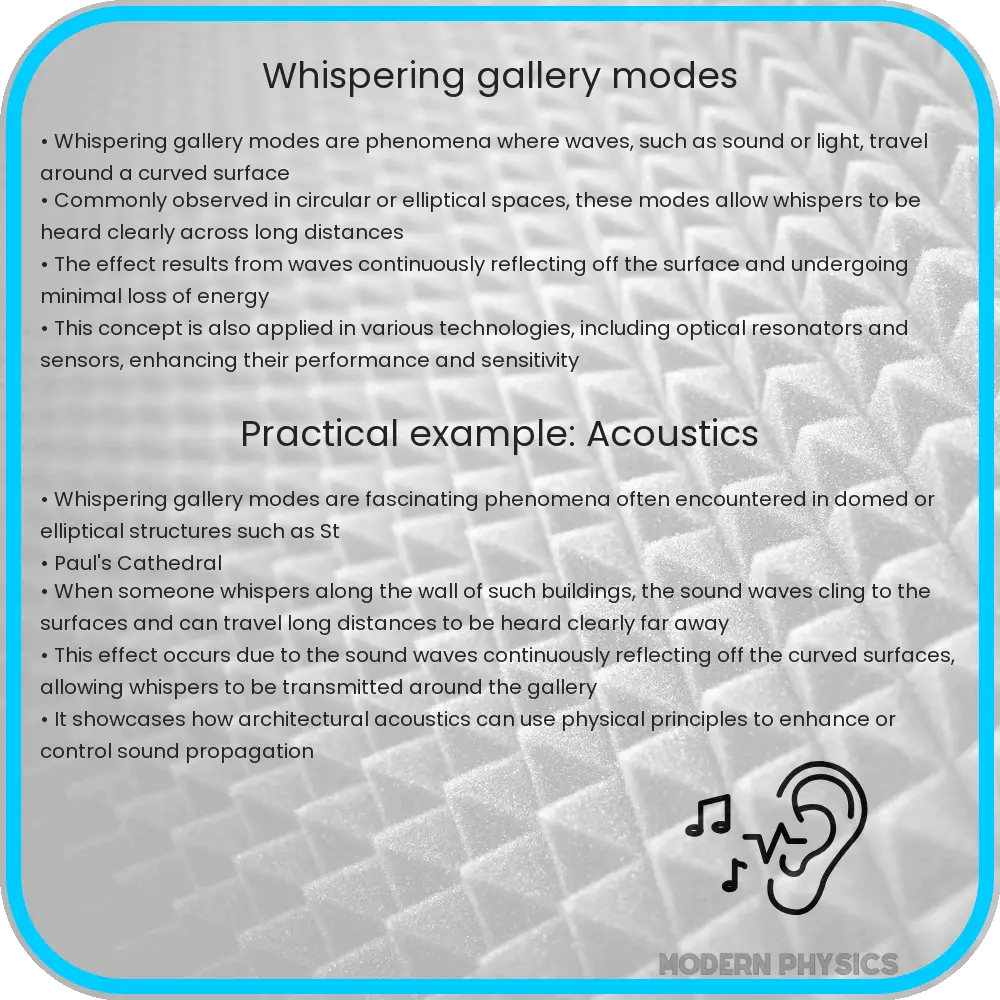Explore the world of Whispering Gallery Modes, their resonance, applications in technology, and theoretical insights in this comprehensive guide.

Whispering Gallery Modes: An Introduction to Resonance Phenomena
Whispering Gallery Modes (WGMs) represent a fascinating area of physics, where resonance phenomena play a pivotal role. Named after the famous whispering gallery in St. Paul’s Cathedral, London, these modes occur when waves, such as light or sound, travel along a curved surface, such as the walls of a circular room or a spherical cavity. The unique feature of WGMs is their ability to confine waves in a small region, leading to high-quality resonances.
Understanding the Basics of Resonance in Whispering Gallery Modes
At the heart of WGMs lies the principle of resonance, a phenomenon where a system oscillates at greater amplitude at certain frequencies known as the system’s resonant frequencies. In the context of WGMs, when a wave’s frequency matches the resonant frequency of the cavity, it can sustain continuous oscillations. This effect is due to the constructive interference of the waves, which reinforces the wave’s amplitude.
Theory Behind Whispering Gallery Modes
The theoretical underpinnings of WGMs are rooted in Maxwell’s equations, which govern electromagnetic waves. The boundary conditions imposed by the curved surface of the cavity play a crucial role in the formation of these modes. Mathematically, the solution to Maxwell’s equations for a spherical cavity, for instance, leads to a set of discrete resonant frequencies. These frequencies depend on the size and shape of the cavity, as well as the refractive index of the material.
Applications of Whispering Gallery Modes
WGMs have found a wide array of applications in various fields. In telecommunications, they are used in optical resonators and filters, enhancing signal quality and strength. In sensor technology, WGMs have been employed to create highly sensitive sensors for detecting minute changes in the environment, such as temperature shifts or the presence of specific molecules. Furthermore, in the realm of quantum computing and optics, WGMs offer a platform for studying light-matter interactions at a fundamental level, opening doors to advanced technological innovations.
In conclusion, Whispering Gallery Modes are not just a curious physical phenomenon but a vital concept with wide-ranging applications in modern technology. Their unique properties allow for the creation of devices with high precision and sensitivity, marking them as a crucial element in the advancement of various scientific and technological fields.
Detailed Insights into the Resonance of Whispering Gallery Modes
The resonance quality of WGMs is characterized by the Q-factor, which measures the sharpness of the resonance. A higher Q-factor indicates a lower rate of energy loss relative to the stored energy, which is crucial in applications requiring high precision. The exceptional Q-factors observed in WGMs, sometimes reaching 1011, make them ideal for tasks where minimal energy loss is paramount, such as in optical filters and lasers.
Advanced Applications and Future Potential
Beyond their current uses, WGMs hold promise for groundbreaking applications in the future. In medical diagnostics, for instance, WGM-based sensors could detect diseases at their earliest stages by identifying biomarkers at extremely low concentrations. In environmental monitoring, they could provide unparalleled sensitivity in detecting pollutants and toxins. Additionally, their potential in the development of next-generation photonic and quantum devices could revolutionize information processing and communication technologies.
Challenges and Limitations
Despite their advantages, WGMs face challenges in practical applications. The precise fabrication of the resonators is often complex and costly, limiting their widespread adoption. Moreover, WGMs are sensitive to environmental factors like temperature and humidity, which can affect their performance. Addressing these challenges is crucial for expanding their applications.
Conclusion
Whispering Gallery Modes represent a striking blend of fundamental physics and practical application. Their ability to confine waves and produce high-quality resonances has opened up new avenues in various scientific and technological fields. From enhancing communication systems to enabling sensitive environmental monitoring and promising advances in quantum technology, WGMs continue to be a subject of intense research and innovation. As we overcome their fabrication and environmental sensitivity challenges, we can expect to see even more groundbreaking applications of these fascinating phenomena in the near future, further bridging the gap between theoretical physics and real-world applications.
